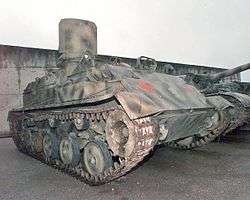OT M-60
| OT M-60 APC | |
|---|---|
|
M-60P | |
| Type | Armoured Personnel Carrier |
| Place of origin |
|
| Specifications | |
| Weight | 11,000 kg |
| Length | 5.02 meters |
| Width | 2.77 meters |
| Height |
2.385 meters with 12.7 mm MG 1.86 meters without 12.7 mm MG |
| Crew | 3 |
|
| |
| Armor | 10-25 mm |
Main armament | 12.7 mm M2 HB Browning heavy machine gun |
Secondary armament | coaxial 7.92 M53 machine-gun 2,000 rounds |
| Engine |
Famos FFTR 150 hp |
| Power/weight | 17,3 hp/tonne |
| Suspension | torsion bar |
Operational range |
400 km on road 250 km off road |
| Speed | 45 km/h on land 8 km/h in water |

The OT M-60, is a Yugoslavian armoured personnel carrier, produced in the 1960s.
Development
The OT (Oklopni transporter - armoured personnel carrier) M-60 was the first Yugoslav serial produced armored vehicle. Research and development of the M-60 began in 1956, and the first prototype has been produced in June 1958. Until the final serial production, the new armoured personnel carrier was known under the designation Objekat M-590. Serial production started in 1962, and M-60 has been publicly presented on Victory day parade, same year. The quality of the vehicles did not satisfy the requirements given by Yugoslav People's Army, so the FAMOS has started the development of upgraded model, OT M-60P (P - poboljšani - improved) which has been introduced in production in 1970. During the serial production, from 1962 until 1979 around 790 vehicles were produced, which from 190 have been exported. In 1973 anti-tank variant with two 82 mm M60 recoilless gun has been developed.[1]
Most of armored personnel carriers consisted armored and mechanized brigades of Yugoslav People's Army, while a number has been used by Federal Police, being painted in a characteristic blue color. With the start of Yugoslav wars, M-60 immediately proved to be obsolete with many defects. Armour protection was weak against almost all anti-armoured weapons, so the M-60 APC's have suffered heavy losses in early conflicts in Slovenia, while firepower was insufficient. Later during the war, this APC was used for transport of ammunition to the front line and evacuation of infantry and wounded. M-60 has been used by almost all armies created in former Yugoslavia. Military of FR Yugoslavia has withdrawn last 121 M-60P APC's from service in 2004 due the arms limitation agreement.
The M-60 armoured personnel carrier had never managed to meet all the required specifications. Despite all disadvantages, it has played a role during its 40 years use. According to its characteristics was generally similar to the other APCs of the period. Most importantly it was inciting mass mechanization of Yugoslav People's Army. Its deficiencies were later compensated with newly introduced BVP M-80 infantry fighting vehicle.
Characteristics
The basic layout is driver front left, his hatch has a day sight, which can be replaced with an infrared for night driving. To his right is the Bow MG operator. The commander sits behind the driver with a 12.7 mm MG on his cupola, which can be used in the Anti-Aircraft role.
The vehicle is powered by a 6-cylinder diesel, which generates 140 hp, giving a top road speed of 45 km/h. The vehicle is an all welded steel construction, which gives protection against small arms. It has no NBC protection system.
The rear compartment is for 10 troops who sit on benches back to back so they can fire their personal weapons through side ports (3 either side) and they depart the vehicle via two doors set in the rear.[2]
Variants
- M-60 - First production model, also known as M-590.
- M-60P - Improved model.
- M-60PB - Anti-tank variant with twin 82 mm recoilless rifles mounted on the top left or top right of hull at rear.
- M-60PK - Battalion commander's vehicle.
Operators
 Yugoslavia - about 600 vehicles in various variants delivered from 1962 to 1979. Passed on to successor states.
Yugoslavia - about 600 vehicles in various variants delivered from 1962 to 1979. Passed on to successor states.
 Croatia
Croatia.svg.png) Bosnia and Herzegovina
Bosnia and Herzegovina Republika Srpska
Republika Srpska Republika Srpska Krajina
Republika Srpska Krajina Serbia and Montenegro - last 121 operational vehicles withdrawn and scrapped in 2004.
Serbia and Montenegro - last 121 operational vehicles withdrawn and scrapped in 2004.
.svg.png) Iraq - 190 M-60P armoured personnel carriers ordered and delivered before 1990.[3] Withdrawn from service.
Iraq - 190 M-60P armoured personnel carriers ordered and delivered before 1990.[3] Withdrawn from service.
References
- Jane’s tanks and combat vehicles recognition guide, Christopher F. Foss, Harper Collins Publishers, 2000.
- Srpski Oklop (Serbian)